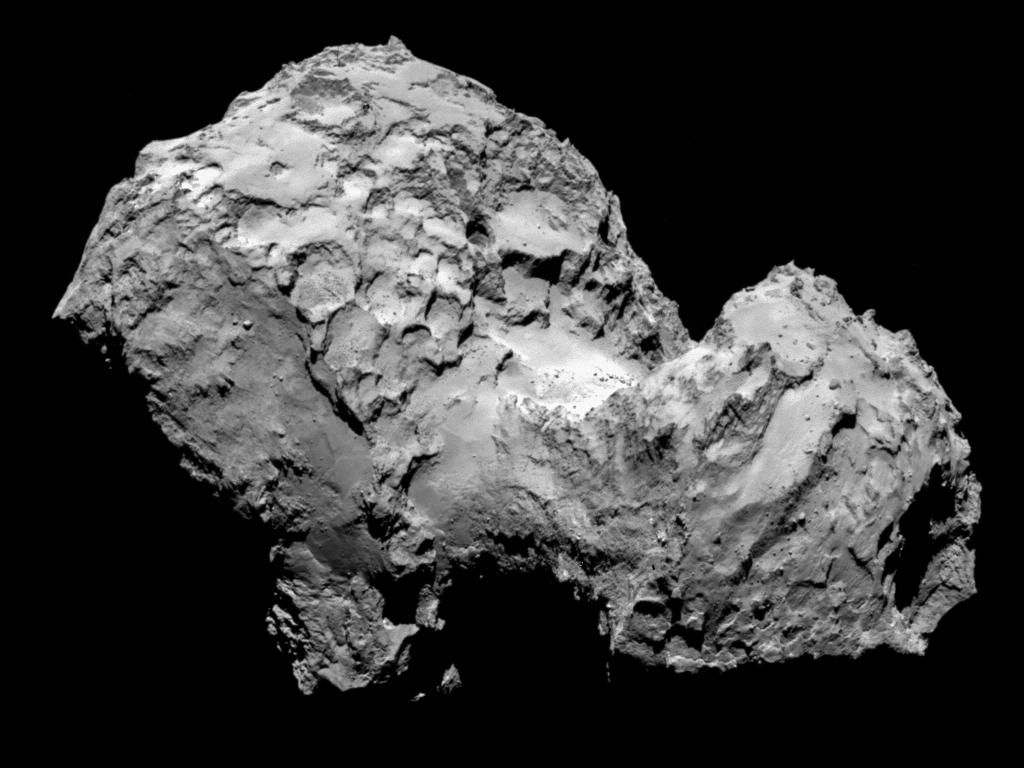| Above: Pluto - for the first time in history we are seeing details of surface features. Courtesy of NASA. |
Comet 67-P: Wreckage from a destroyed world?
Ever since the Rosetta spaceprobe arrived in the vicinity of comet 67-P, we've been debating the origin of the comet's famous rubber ducky shape:
 |
| If that's an ugly duckling then it's got a lot of work to do to earn a Disney song and a heart warming transformation into a swan. courtesy of ESA |
Now, that's a pretty damn deformed duck. I mean, seriously, change the bathwater and stop letting your kid play with a flamethrower in the bath. But, deformed-duck-like or not, one thing is clear: 67-P has two big lumps (called lobes, because scientists need to sound scienc-ey), joined by a short neck. Other comets have ranged from spherical-ish to potato shaped, so what's different here? Two main theories were floated: This was the result of a strange pattern of erosion (the comet gets some fierce erosion it passes by the Sun), or the comet was formed from a gentle collision between two smaller comets. My money had actually been on the first idea, as it's hard to see how comets - objects that move at speeds of over 30 km/ second - could come together 'gently'. But a paper just released by the Rosetta team - full paper here - has used data from the probes OSIRIS instrument to show that a gentle collision actually fits what we see on the comet quite well.
The team have a couple of possible explanations: 67-P may have formed during the very earliest years of the solar systems formation, when collision speeds were low and large solid objects were rare. That would make 67-P a hard core survivor, as it would have had to get through the next few tens of millions years, when the solar system was a cosmic shooting gallery of comets and asteroids. Another possibility is that, during the solar systems later phase of formation, 67-P was formed in the aftermath of the death of a larger, icy, world. The most likely culprit would be a collision between the 67-P parent world and some other fast moving object, resulting in a cloud of debris. The fragments in the debris cloud wouldn't have had much speed relative to each other, and so we have a scenario where a nice gentle collision seems possible.
This would mean that 67-P carried information, not just about how the solar system formed, but about one of the earliest large solid worlds to form in it. Both sections of the comet contain distinct layers, and the team speculate that, if the comet is made from fragments of some bigger world, these layers might be inherited from that parent body. They would hold a record of that worlds history if so - much like the rock layers do here on Earth.
.jpg) |
| Above: Rock strata on Earth. Are tthese a distant relative of the layers on 67-P? They will probably smell better, either way. |
Elsewhere in the Universe:
SpaceX have been cleared to launch US military satellites, which should mean a boost in business for them. They have also released a video from inside their Dragon mark 2 space capsule, during a recent test flight that tested its emergency abort engines:
Above: I want one. I won't get one, but I'm going to want one anyway. Courtesy of SpaceX.
The private spaceflight industry is heating up in an unexpected way: There are a number of companies who are looking to develop vehicles that can take a human crew on a sub-orbital trip and launch nanosats - miniaturised space satellites like the recently launched lightsail 1 - all the way into orbit. These include some of the best know space start-ups, like Virgin Galactic. Virgin plans to use their White Knight aircraft as a flying launch platform for their Launcher 1 unmanned orbital rocket, as well as their Space Ship 2 manned sub orbital craft.
Above: A quick lowdown on Virgin Galactic's Launcher 1 space craft. Courtesy of TMRO.
In fact the whole field of nanosat launches is looking to be getting more and more busy - is the future of space exploration going to follow the pattern of computers, and be about miniaturisation? Here're a few recent developments:
Above: Swiss Space Systems are a relatively new player, and their sub-orbital minishuttle + orbital rocket combo looks like it has a lot of promise. Courtesy of Swiss Space Systems
Above: A successful test flight for the Interorbital team. It's not their own ISS exactly, but it's more than I did with my lunchtime (which was eat delicious chicken wings). Courtesy of Interorbital.
Above: A quick run down on Interorbitals unique design for a multi-engine orbital rocket. Courtesy of Interorbital.
Ceres gets more mysterious:
The King of the Dwarf planets has a few strange marks on its face. As more and more detailed images pour down from the Dawn space probe the mysteries just seem to deepen. The mysterious bright spots still refuse to give up their secrets, and the probe is beginning to see evidence of mountains, fault lines, and perhaps even volcanic domes - all of which suggests that Ceres had - and maybe still has - some kind of active geology. One especially good animation from ZLD over at unmannedspaceflight.com highlights a bright crater that has an unlikely, steep walled /conical structure:
Elsewhere on the internet:





















